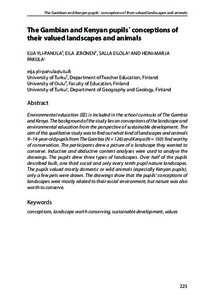The Gambian and Kenyan pupils´ conceptions of their valued landscapes and animals
Salla Eilola; Eija Yli-Panula; Eila Jeronen; Heini-Marja Pakula
https://urn.fi/URN:NBN:fi-fe2021042823365
Tiivistelmä
Environmental education (EE) is included in the school curricula of The Gambia and Kenya. The background of the study lies on conceptions of the landscape and environmental education from the perspective of sustainable development. The aim of this qualitative study was to find out what kind of landscapes and animals 9–14-year-old pupils from The Gambia (n = 126) and Kenya (n = 150) find worthy of conservation. The participants drew a picture of a landscape they wanted to conserve. Inductive and abductive content analyses were used to analyse the drawings. The pupils drew three types of landscapes. Over half of the pupils described built, one third social and only every tenth pupil nature landscapes. The pupils valued mostly domestic or wild animals (especially Kenyan pupils), only a few pets were drawn. The drawings show that the pupils’ conceptions of landscapes were mostly related to their social environment, but nature was also worth to conserve.
Kokoelmat
- Rinnakkaistallenteet [19250]
